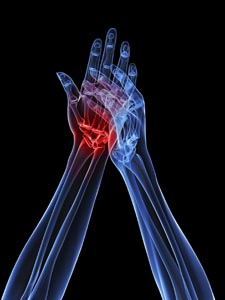The University of Alabama at Birmingham is establishing a Center of Research Translation to improve the health of an increasing number of patients with gout and hyperuricemia. The UAB CoRT will be funded by a five-year, $5.3-million grant from the National Institute of Arthritis and Musculoskeletal and Skin Disease, one of the National Institutes of Health.

“We use the theme ‘from bench to bedside to backyard,’ meaning we intend to take discoveries surrounding gout treatment or prevention from the laboratory to the patient to help them return to the everyday activities they enjoy,” says Kenneth Saag, M.D., the Jane Knight Lowe Professor of Medicine in the Division of Clinical Immunology and Rheumatology and center co-director. “We’re investigating several new drugs for the treatment of gout, and with the addition of the CoRT we will be able to significantly expand our scope.”
Gout is a form of inflammatory arthritis that occurs when uric acid builds up in blood and causes joint inflammation, most commonly in the big toe. It affects about 2 percent of Americans and is expected to increase as the U.S. population ages. It occurs more frequently in men than in women.
While the causes of gout are well known and treatments are available, large gaps exist in the quality of patient care. For example, gout is more common among African-Americans than Caucasians, yet little is known about the way environmental factors increase the risk in this minority population.
UAB CoRT researchers will work to better understand the real-world effectiveness of gout therapy on cardiovascular outcomes and the safety of treatment regimens and develop a virtual gout clinic to identify the best evidence-based practices in treatment.
| “This new center, in association with our current efforts, will translate best practices into widely usable treatment strategies. We will do that by applying scientifically rigorous, state-of-the-art methodology to clinically important questions and educating clinical investigators in ways to predict, treat or prevent gout,” says S. Louis Bridges, Jr., M.D., Ph.D., director of the Division of Clinical Immunology and Rheumatology and co-director of the UAB CoRT. |
“This new center, in association with our current efforts, will translate best practices into widely usable treatment strategies,” says S. Louis Bridges, Jr., M.D., Ph.D., director of the Division of Clinical Immunology and Rheumatology and co-director of the UAB CoRT. “We will do that by applying scientifically rigorous, state-of-the-art methodology to clinically important questions and educating clinical investigators in ways to predict, treat or prevent gout.”
The UAB CoRT will strive to conduct innovative research using state-of-the-art tools from translational research areas of epidemiology, biostatistics and health outcomes. It will foster the development of pilot and feasibility projects, apply new translational methods to research in gout and hyperuricemia, and promote training for clinical investigators in these methods.
In addition to the gout CoRT, UAB is testing new therapeutic compounds and also is establishing a gout clinic in the Kirklin Clinic to be led by UAB CoRT Associate Director Jasvinder Singh, M.D.